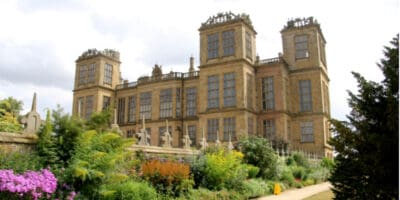24/03/22How the British garden has changed over the centuries and shaped modern outdoor spaces

British people love to enjoy their gardens and get their hands dirty cultivating outdoor spaces. It’s a love that can be traced back centuries to Roman occupied Britain. If you’re starting to think about spring projects to transform your garden, looking at the history of British gardens could provide you with some inspiration.
Research from the Royal Horticultural Society estimates that there are 33 million gardeners across the UK. By 2030, it’s estimated that the ornamental horticulture and landscaping industry will be worth a huge £42 billion. So, if gardening is a pastime you enjoy, you’re certainly not alone.
And, gardens being important to British people isn’t a new phenomenon.
Romans (43 – 410)
The earliest evidence of gardens in Britain dates back to the Roman period, and there are a few examples that you can visit today.
The Roman period started in the year 43 and historians know that large villas and palaces included gardens. Unsurprisingly, the gardens were influenced by designs from Italy and often featured enclosed courtyards, orchards, and frescos. Gardens in Italy during this time also incorporated outdoor dining, statues, pools, and fountains, and it’s likely British gardens followed some of these trends.
A visit to Fishbourne Roman Palace and Gardens in Sussex can give you a glimpse of what life, and gardening, was like during the time of the Romans.
Medieval (1066 – 1485)
After the Roman period ended in 410, there’s a gap in our knowledge of what gardens were like until the medieval period from 1066. It’s suggested by some historians that Anglo-Saxons did not place importance on gardening, leading to this gap.
By the medieval period, gardens were well used. In practical terms, they were used to grow fruit and vegetables, as well as plants for medicinal use. When visiting medieval castles or monasteries, you may find they have space for kitchen and herb gardens. In addition, flower borders, lawns, and arbours were also popular.
You can still see the features of medieval gardens when visiting historic buildings today, including Avebury Manor in Wiltshire and Cotehele in Cornwall.
Tudor (1485 – 1603)
Tudor gardens were designed to impress, show off the wealth of owners, and mirror the alignment of the property.
Tudor gardens were often split into different sections, with each containing a different type of garden, from fish ponds to garden knots. Once again, British gardens were heavily influenced by Italy, which was experiencing the Renaissance. Much like the Roman period, it became common to see statues and fountains.
Sadly, no Tudor gardens have remained intact, but there are plenty of faithful reconstructions to explore around the UK, including Hardwick Hall, Derbyshire, and Little Moreton Hall, Cheshire.
Stuart (1603 – 1714)
During the Stuart period, British gardens moved away from Italian influences and, instead, followed the trends of France.
This was the time when a broad avenue sweeping up to a house, often lined with trees, became popular, alongside parterres, elaborate formal gardens, and expanses of water that could be used for pleasure boats. Topiary was also used to control nature as natural and wild gardens fell out of favour.
Blickling Estate, Norfolk, and Chastleton House, Oxfordshire, are both great places to visit if you’d like to see how a garden would have looked.
Georgian (1714 – 1837)
In the Georgian period, gardens started to become a little less formal. British landscaped parks influenced gardens throughout Europe.
Gardens no longer had straight, symmetrical designs, as paths curved through the landscape instead. This approach made houses a part of the surrounding landscape and favoured a more natural look when planting trees and creating lakes. It’s also during this period that gardeners began to add temples, grottos, and statues to visit while walking along the paths.
There are plenty of gardens you can visit and stroll around with Georgian features. Among them are Croome, Worcestershire, and Osterley Park and House, London.
Victorian (1837 – 1901)
During the Victorian period, interest in gardening really exploded.
There were lots of innovations that mixed formal gardens, exotic plants grown in greenhouses, and beautiful terraces. Bright colours and intricate designs were popular. But there was still demand for the wild, informal gardens of the Georgian period. Sometimes these distinct aesthetics were combined in the same garden.
Public parks and green spaces also started to grow during this time. These were often characterised by large open green spaces, ornamental lakes, elaborate flower beds, and woodlands.
If you’re interested in seeing a Victorian garden, you should plan a visit to Bodnant Garden, Conway, or Gawthorpe Hall, Lancashire. The People’s Park in Halifax is also an excellent example of a public park created in 1857.
20th century (1901 – 1999)
Finally, in the 20th century, gardens were heavily influenced by the arts and crafts movement, which attempted to reform design and decoration in Britain.
These gardens combined formal and informal elements to create what’s often thought of as a traditional English cottage garden. Key features included borders filled with colourful plants, pergolas covered with climbing vines, and wildflower meadows.
Many properties across the UK feature styles from the 20th century to enjoy, such as Sissinghurst Castle, Kent, and The Courts Garden, Wiltshire.
Why our outdoor spaces are so important
Gardening or simply enjoying your outdoor space can have a positive effect on your wellbeing. According to the Office for National Statistics, 9 in 10 people agree that natural spaces are good for their mental health and wellbeing.
Creating a garden that you love can provide you with an oasis to unwind and spend time with family. With spring arriving, now is the perfect time to plan some gardening projects – perhaps you’ll even draw inspiration from times past.

